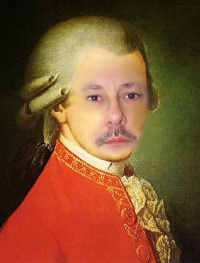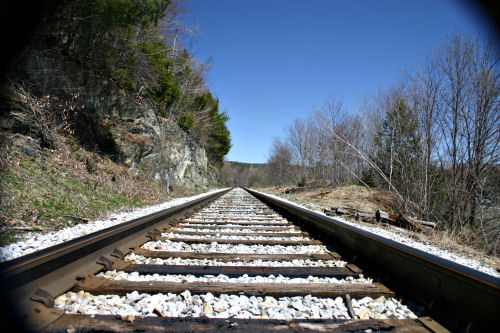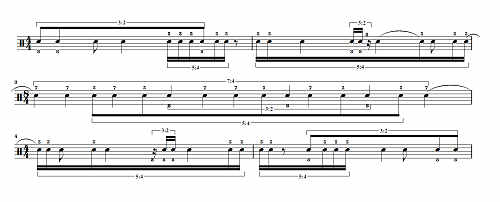A 365-Day Project
"We Are All Mozart"
A project to create
new works and change
the perception of the
music of our time.


 December 3, 2006
December 3, 2006 
In this (unexpectedly) multi-part look at rhythm in music, biological and planetary perspectives, rhythmic unbinding, and contact perception have been mentioned. I apologize to the non-musician readers for this foray into the abstruse, but it's an area a composer friend thought might interest me -- and, to my surprise, it has, particularly since it's not a topic of interest beyond actually writing the music with unverbalized rhythmic concepts. And so here we are.
Yesterday was left without discussing some scientific elements with natural roots, more considerations of speech, and the threshold of rhythm and form. Before explorations of those topics comes at least one more other curiosity: the rhythmic trick. That's not meant pejoratively -- the rhythmic trick is the re-organization of spacing and the mixing of rhythmic 'modules' to create an unfamiliar temporal feel, hiding what is at heart a metric regularity. This is in some ways what the new complexity composers do (with other purposes in mind), but it has a simpler and more skeletal form, as seen in Larry Polanksy's body of canons. This approach is difficult to explain, so here is one of these canons (click the image for a larger, more legible verson):
Three questions arise in looking at this canon. First, is it performable? Yes it is. It's not easy to assess the durations because the tuplets are interleaved, but with practice (and coaching from an electronic playback of the rhythms), it's learnable. Each measure is correctly filled, so it's a matter of learning how to feel fragmentary tuplet patterns.
The second and more interesting question is whether this contributes a new and useful paradigm to musical rhythms. It is notated in notes and measures, so it 'looks' like an ordinary if complex rhythm. But the measures change value, and there are those ties across 2-3 and 3-4. Whence does such a complex pattern arise, and what is its value? Is it just arbitrary nonsense? I have not discussed this with Larry, other than having engraved it and having gotten his permission to use the piece -- Nickerballs, one of a set of unfinished pieces for six instruments or six percussion, a subseries of the piece called Tetherball -- so I am guessing at something. First, listen to a straight-out rendering on piano and again on three synth toms, but a little faster. What does it feel like?
Now consider this text:
|
What do you think? It wasn't him, you know. It was me -- and John, too. Has he got the... mumps, the plague, the sick sense that I have just had it with him? I don't think so. I dunno. He's a bastard. Plus, I don't like him. That's enough! |
You see where I'm going with this. So here's me reading the text and here's a mix with the toms. No, this isn't perfect -- just a sketch, and maybe something Larry didn't have in mind at all, but on listening to the push-pull of the tuplet rhythms, I sensed speech more than music. The third question, then: is it useful? I'm not sure. This piece is a complex bit of notation that at the same time sounds full of natural cadences; perhaps it has the same problem as The Moon (mentioned yesterday) in that the notation might become impossible or at least enormously unwieldy in a group situation.
(An aside regarding Larry Polansky. He has a collection of rounds that's just been made available, containing pieces by a dozen composers. Grab a copy of the PDFs from a small book of rounds from Larry's site, or contact him. He says, "I'm happy to send a free copy of the current one (it's always changing!) to anyone who wants one.")
Onward, backward and sideways to expression. Beethoven's metrical slowdown in Coriolanus is an example of fixing expressive content, and it's an experiment I have been doing for entire compositions for a few years. The most recent example is L'Estampie du Chevalier, a string quartet composed for an ensemble in Ghent. The piece is not technically formidable save for one aspect: All the expressive motion in time is written into the notation, an attempt to subvert the rhythmic feebleness of the foursquare measures and their subdivisions usually into twos and threes by slipping note changes before and after the beat, and sometimes out-of-sync with other performers. In both rehearsal and performance, the results were acoustic wreckage. The performers added their shifts of stress and phrasing atop those already in place, causing loss of synchronization and an insecurity that at times bordered on aleatory.
This method of pseudo-biological temporal modulation, similar to its use in fixed-media works and computer-assisted playback, is a significant concept in organizing rhythmic space. It requires a precision of playing that at the same time does not deny the expressive character of performance itself. It may breathe, but in present-day performance technique, it seems prone to failure.
Other natural rhythmic organization includes long shapes. Under the horizon of immediate perception, these shapes are at the threshold of rhythm and form. In the notes to my orchestral composition Softening Cries, I wrote, "a dream-suspended F-major chorale of 42 notes (12 'measures') is pulled across the entire 15 minutes, with its changes stretching and shrinking via prime numbers (17 to 43)." Such long rhythms are imperceptible at normal speed, but the idea of speeding up such structures to hear them, then slowing them down again to restore their 'dream suspension' (with the memory of the long rhythm) provides the same sort of transition as does moving perceptible rhythms to pitches and back to rhythms. (This time-suspension has been explored recently with Beethoven in Leif Inge's 9 Beet Stretch, where Beethoven's last symphony is stretched carefully across twenty-four hours with all its pitches and relationships otherwise intact.)
With imprinting, there comes an expectation of the long rhythm -- we as listeners know when the change is coming, and prepare for it. For example, my own knowledge of Beethoven's Missa Solemnis came via a stack of 78rpm records. To this day, forty years later, I still feel my body preparing for the moment when the sound stops and the new record drops from the stack. With music, we are not forgetful. In the senses, we are not forgetful, for in the country at least, our bodies know when sunrise comes, even with the curtains drawn and the seasons changing. We feel the moon's phases, even under cloud cover, and sailors know the rhythm of tides and stars.
One might dismiss these last as a kind of pastoral fiction, particularly among those who have alienated themselves in artificially lit rooms and sun-blocking cities, but the biological and planetary rhythms exist. It interests me to attempt the restoration of the longer time scales to music without sacrificing the short ones. Does this mean an urban audience has been trained out of perceiving them? It is likely more a willingness, but the experiment still needs to be done. Television viewers receive increasingly fast-paced montage: When I began counting a decade ago, the average montage of thirty seconds contained fifteen cuts; now it is often greater than thirty. Our experience of micro-rhythm is being enhanced by montage and the mix of sonic elements in advertising and pop music, and even if it remains simple rhythm, as a whole (during a commercial in particular), it breathes as if it were a thirty-second measure with shifts inside it -- like, perhaps, the rhythm of speech with the notational subtlety of Polansky's Nickerballs.
To be continued again.

Consider these tracks by our house as they move far away toward a vanishing point. The photograph's perspective alters the reality we think we know. Looking straight down between cars on the train itself, the tracks remain parallel and the distance short. Yet looking back from the train, I would be standing on the vanishing point. The rhythm shifts in time and space. There are near-regular rhythms of ties which appear not to be, and gravel which gets smaller. Likewise, my sense of motion is based on whether I am on or off the train, and where I stand. If we turn this image clockwise and play what we 'know', the tracks are a steady tone and the ties a continuous beat. If we play what we see in the photograph, the tones converge and the rhythm speeds up. Which perception is part of a composition?
